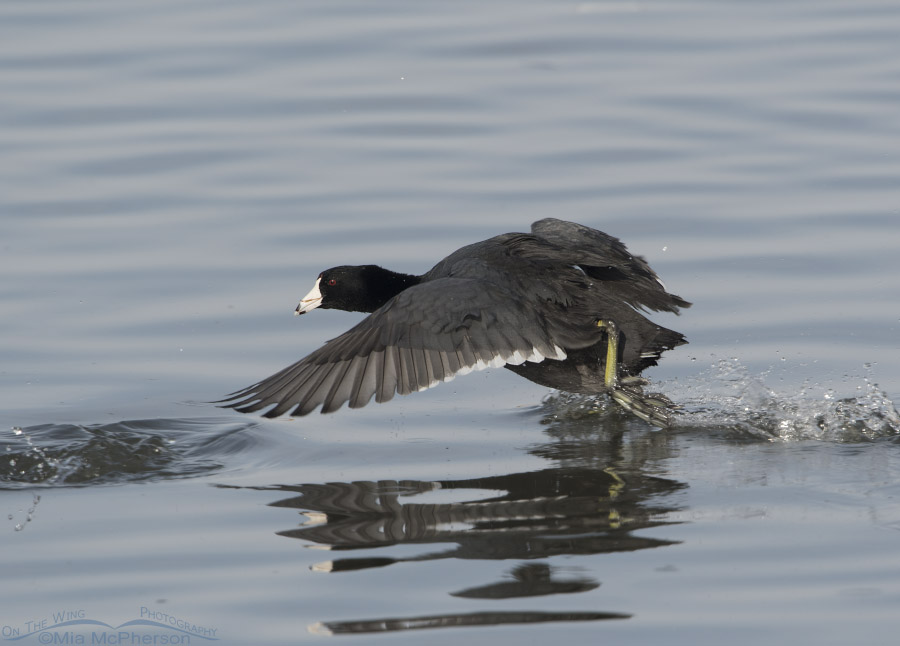 American Coot being chased at Farmington Bay – Nikon D500, f7.1, 1/1250, ISO 250, Nikkor 500mm VR with 1.4x TC, natural light
American Coot being chased at Farmington Bay – Nikon D500, f7.1, 1/1250, ISO 250, Nikkor 500mm VR with 1.4x TC, natural light
The other day when I photographed Common Mergansers and Pied-billed Grebes at Farmington Bay I was also able to photograph some American Coots that were nearby. Most of the coots were feeding on aquatic plants but a few were feeling frisky, even aggressive on the sunny winter day.
I heard splashing and the sound of feet running across the water and turned my lens toward the sounds then locked my focus on one the the running coots and started firing away. These images are posted in the order that they were taken in.
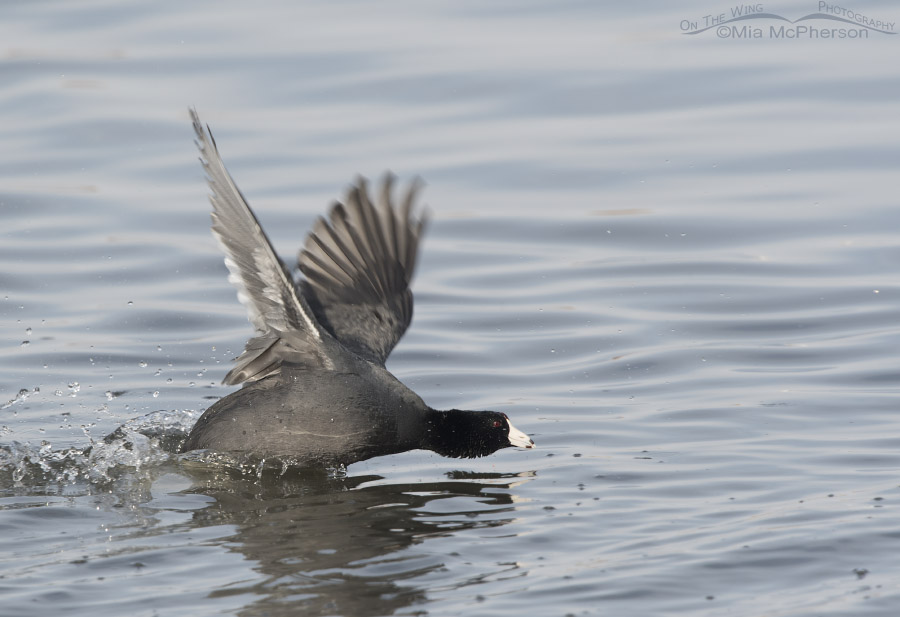 American Coot being chased past me – Nikon D500, f7.1, 1/1000, ISO 250, Nikkor 500mm VR with 1.4x TC, natural light
American Coot being chased past me – Nikon D500, f7.1, 1/1000, ISO 250, Nikkor 500mm VR with 1.4x TC, natural light
And the chase was on. American Coots are quarrelsome birds and they are quick to give chase whether it is over food or territory and they will fight, sometimes even to death, for both.
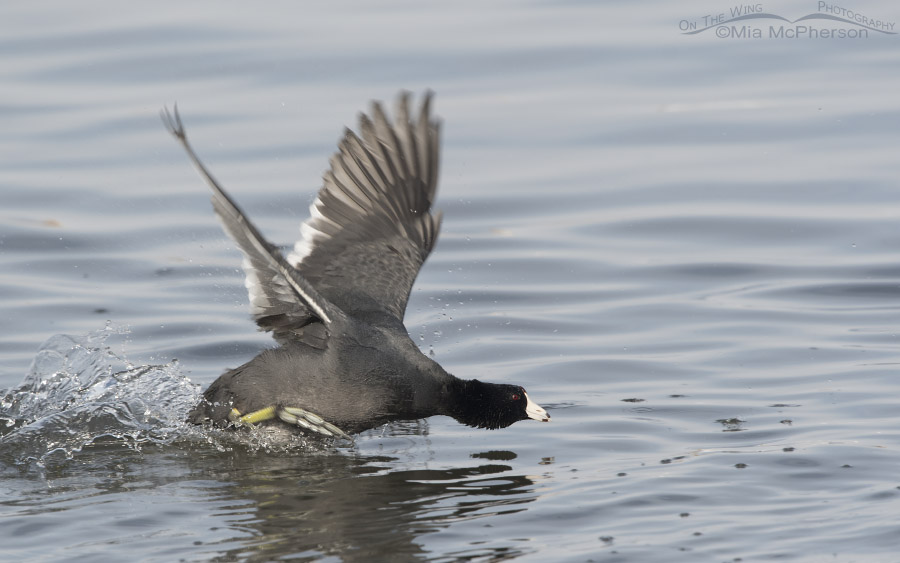 American Coot with water droplets flying – Nikon D500, f7.1, 1/1000, ISO 250, Nikkor 500mm VR with 1.4x TC, natural light
American Coot with water droplets flying – Nikon D500, f7.1, 1/1000, ISO 250, Nikkor 500mm VR with 1.4x TC, natural light
This aggressive behavior is sometimes called “splattering” but most people just prefer to say chase, I prefer chase because it is easier to say. The aggressor chases after the coot that has encroached on its territory.
Most of the time I am only able to photograph one of the birds in the interaction because of the distance between the two birds.
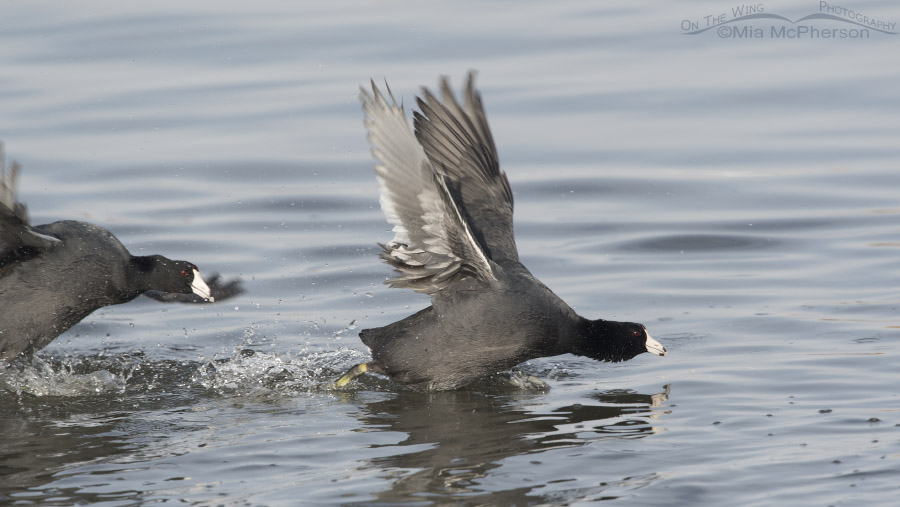 One American Coot chasing another coot – Nikon D500, f7.1, 1/1000, ISO 250, Nikkor 500mm VR with 1.4x TC, natural light
One American Coot chasing another coot – Nikon D500, f7.1, 1/1000, ISO 250, Nikkor 500mm VR with 1.4x TC, natural light
But there are times I get lucky and can have both birds in the frame as the aggressor gets closer to the interloper.
Normally I don’t like to clip body parts of birds in my images but to show this chase I wanted to include these frames because of the behavior and action in the images.
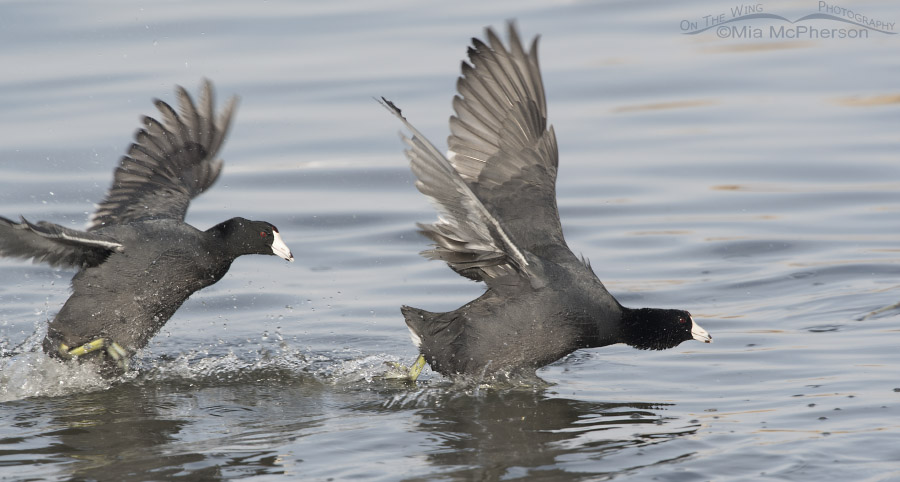 The aggressive American Coot on the other coot’s tail – Nikon D500, f7.1, 1/1000, ISO 250, Nikkor 500mm VR with 1.4x TC, natural light
The aggressive American Coot on the other coot’s tail – Nikon D500, f7.1, 1/1000, ISO 250, Nikkor 500mm VR with 1.4x TC, natural light
The coot on the left side of the frame is gaining on the coot it is chasing in this photo, the coot in the front just wants to get away from it as fast as it can.
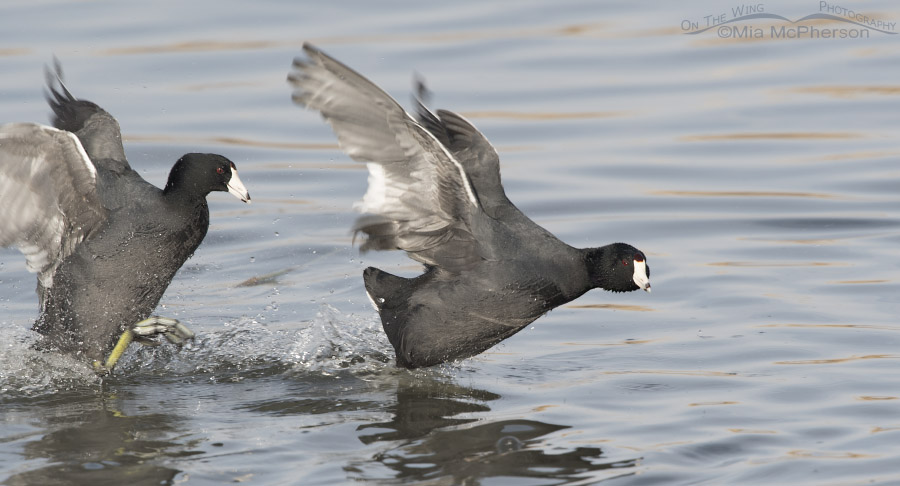 American Coot about to overtake the other coot – Nikon D500, f7.1, 1/1000, ISO 250, Nikkor 500mm VR with 1.4x TC, natural light
American Coot about to overtake the other coot – Nikon D500, f7.1, 1/1000, ISO 250, Nikkor 500mm VR with 1.4x TC, natural light
The coot in the front turned its head just enough so it can see how close the aggressive birds is. That coot is almost close enough to use its feet or bill on the coot in the front in this frame.
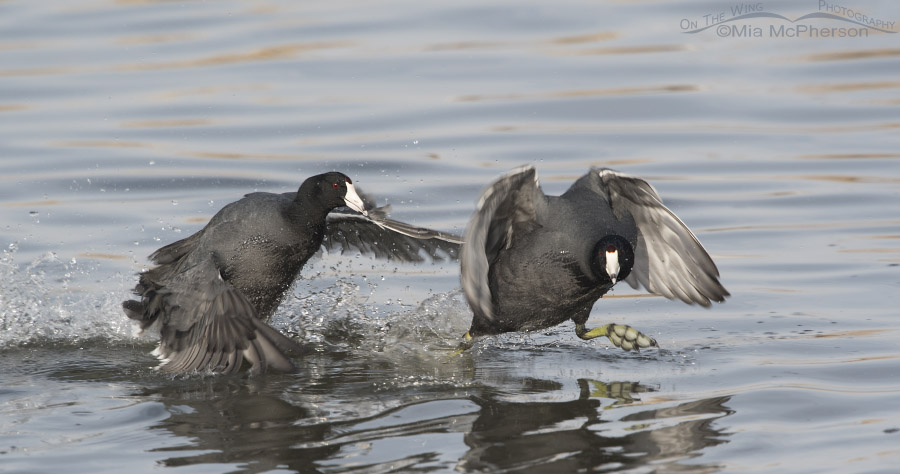 American Coots running on the water – Nikon D500, f7.1, 1/1000, ISO 250, Nikkor 500mm VR with 1.4x TC, natural light
American Coots running on the water – Nikon D500, f7.1, 1/1000, ISO 250, Nikkor 500mm VR with 1.4x TC, natural light
And the coot is even closer in this frame.
Following the coots with my lens and keeping them in focus is not an easy task, they are moving fast when chases occur. Real fast.
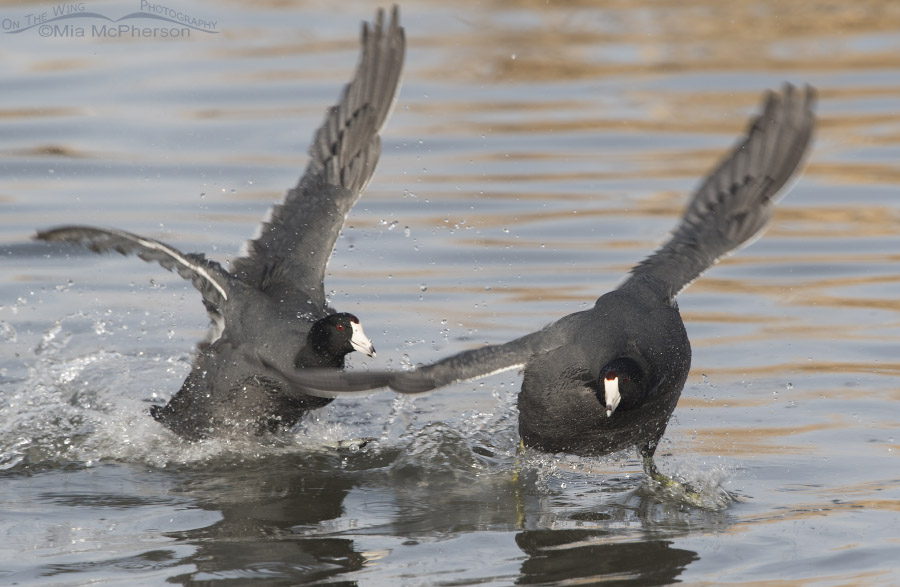 One American Coot turns during the chase – Nikon D500, f7.1, 1/1000, ISO 250, Nikkor 500mm VR with 1.4x TC, natural light
One American Coot turns during the chase – Nikon D500, f7.1, 1/1000, ISO 250, Nikkor 500mm VR with 1.4x TC, natural light
The American Coot being chased must have decided to take evasive action at this point because it turned sharply and headed to the south.
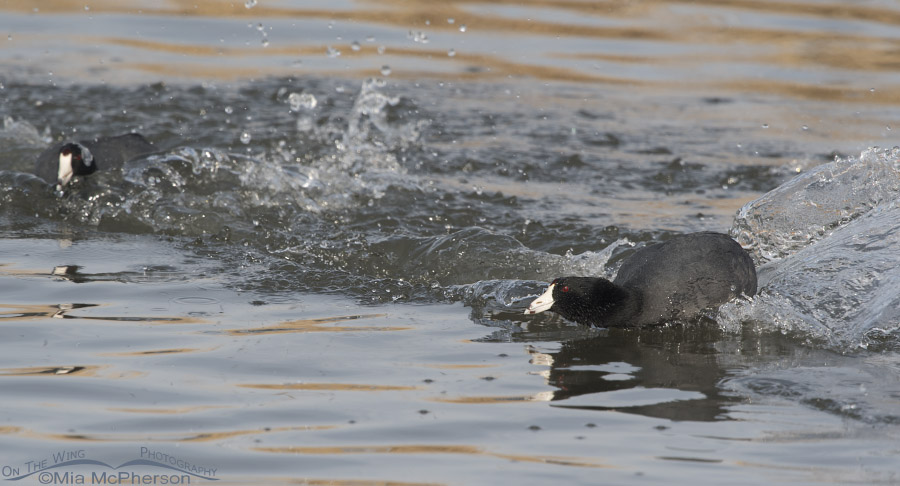 End of an American Coot chase – Nikon D500, f7.1, 1/1000, ISO 250, Nikkor 500mm VR with 1.4x TC, natural light
End of an American Coot chase – Nikon D500, f7.1, 1/1000, ISO 250, Nikkor 500mm VR with 1.4x TC, natural light
Then the coot being chased put the brakes on spraying water out behind its body. The aggressive coot must have thought it had chased the interloper far enough from its territory because it stopped the chase at this point. Of course I can’t know what either coot was thinking so I am only speculating on why the chase ended here and didn’t continue on to an actual physical fight.
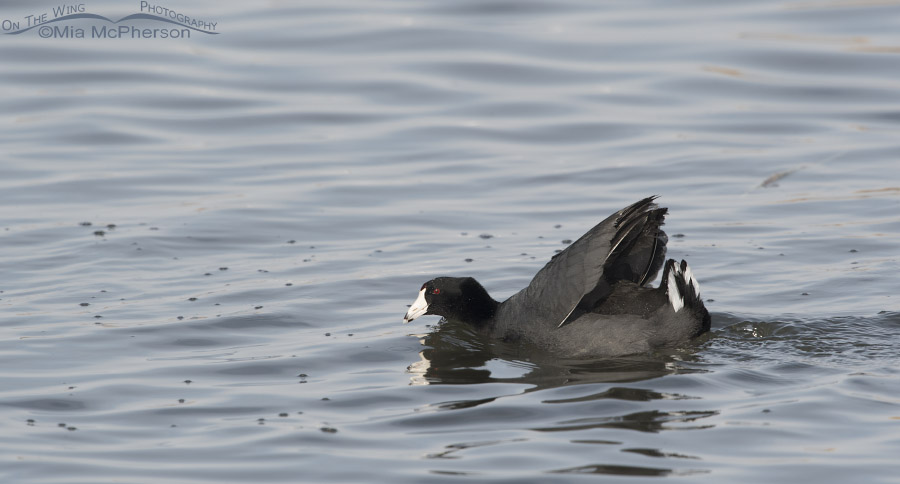 American Coots displaying under tail coverts – Nikon D500, f7.1, 1/1250, ISO 250, Nikkor 500mm VR with 1.4x TC, natural light
American Coots displaying under tail coverts – Nikon D500, f7.1, 1/1250, ISO 250, Nikkor 500mm VR with 1.4x TC, natural light
At the end the coot that had been chased displayed its under tail coverts, lowered its head and arched its wings over its body as the aggressive coot turned its body and swam off in the other direction.
These communicative behaviors as described on Birds of North America Online (BNA):
Body Posture – head and neck erect indicates amiable intentions while a head-lowered/extended posture characterizes aggressiveness and a bowed head is basis of courtship and mating displays;
Under Tail-Coverts – used as a “social releaser” being raised and expanded to increase amount of white displayed;
Wing-Arching – often indicates difference between antisocial versus amiable/amorous intentions
American Coots aren’t flashy birds to look at but they are often exhilarating and exciting to observe and photograph because of their behaviors. I am glad I have so many opportunities with them.
Life is good.
Mia
Click here to see more of my American Coot photos plus facts and information about this species.


A wondeful, exciting series! Amazing that you were able to capture both birds in such detail, especially considering how fast they appear to have been moving!!!
This is such a wonderful series. I was lucky enough to capture a series of chase photos once, so I know how difficult it can be to get these photos. I certainly didn’t do so well! Beyond that, there are a couple of images here I really appreciate: particularly, that last photo. I’ve never seen a tail raised like that, and now I’ll know to look for it when I’m out and about.
I don’t often comment, but I never miss a post. Your work is delightful and informative.